Diagramming Dependent Clauses
Diagramming dependent clauses can help us with correct pronoun usage. To diagram an entire complex sentence, we attach the dependent clause to the independent clause by connecting the relative pronoun to its antecedent with a dotted line. We place the dependent clause below the independent clause.
- George Washington, whom I admire, commanded the Patriot troops.
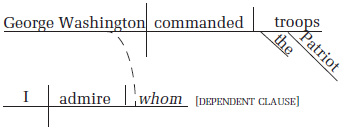
Examples 1
Diagramming dependent clauses shows how words function in clauses. Diagram the dependent clause to help you determine whether the pronoun is a subject or an object in the clause. Then choose the correct pronoun form.
- That dentist, (who, whom) I admire, has moved to Spain.
- Dr. Wu, (who, whom) lives in Denver, travels frequently.
- Mr. Green, (who, whom) writes music, has two daughters.
- Only Tony, (who, whom) I recognized, arrived on time.
Solutions
1. That dentist, whom I admire, has moved to Spain. (object)

2. Dr. Wu, who lives in Denver, travels frequently. (subject)

3. Mr. Green, who writes music, has two daughters. (subject)
4. Only Tony, whom I recognized, arrived on time. (object)
Examples 2
Diagram the sentence to help you determine whether the relative pronoun is a subject or an object. Then choose the correct pronoun form.
- Those violinists, (who, whom) I recognize, are playing Stradivarius violins.
- Nicolo Amati, (who, whom) taught Stradivari, shared traditions of the Cremonese instrument makers.
- George Washington, (who, whom) many idolized, opposed anarchy.
- James Madison, (who, whom) drafted the Constitution, became our fourth president.
Solutions
1. Those violinists, whom I recognize, are playing Stradivarius violins. (object)
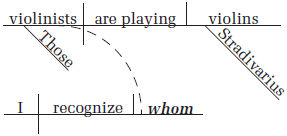
2. Nicolo Amati, who taught Stradivari, shared traditions of the Cremonese instrument makers. (subject)
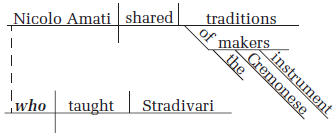
3. George Washington, whom many idolized, feared anarchy in democracy. (object)
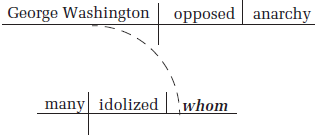
4. James Madison, who drafted the Constitution, became our fourth president. (subject)
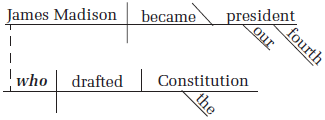
Examples 3
Diagramming dependent clauses helps us to see whether a pronoun is used as a subject or an object. Either on paper or in your mind, diagram the following sentences to help you to choose who (subject) or whom (object).
- The popular congressman, (who, whom) was running for re-election, began his speech with a joke.
- Mrs. Green, (who, whom) I mentioned earlier, sells computer software.
- My cousin Justin, (who, whom) teaches music, will hold a recital next month.
- The bearded man in the dark suit, (who, whom) you probably recognize, trains wild animals.
- The wife of the man (who, whom) trains wild animals is not here.
- I know neither of the people (who, whom) they talked about this morning.
Solutions
- The popular congressman, who was running for re-election, began his speech with a joke. (Think, "who was running.")
- Mrs. Green, whom I mentioned earlier, sells computer software. (Think, "I mentioned whom.")
- My cousin Justin, who teaches music, will hold a recital next month. (Think, "who teaches music.")
- The bearded man in the dark suit, whom you probably recognize, trains wild animals. (Think, "you recognize whom.")
- The wife of the man who trains wild animals is not here. (Think, "who trains wild animals.")
- I know neither of the people whom they talked about this morning. (Think, "they talked about whom.")